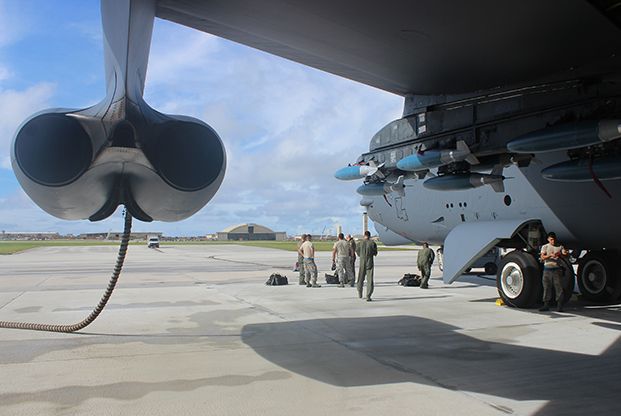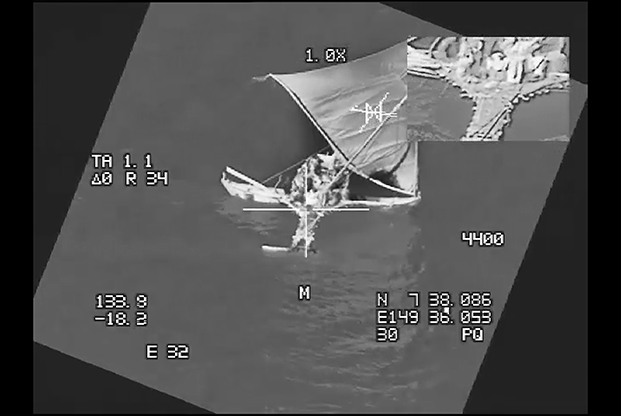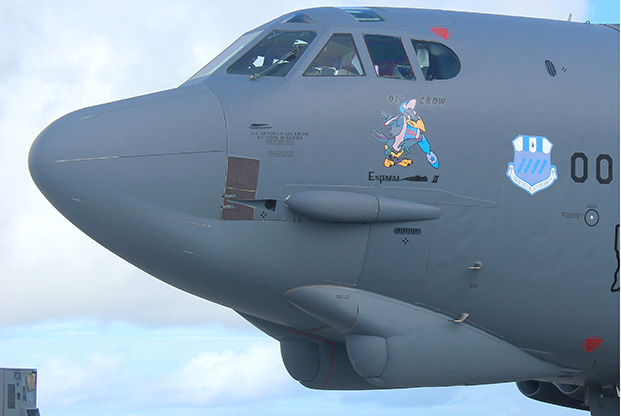
Airmen at Andersen AFB, Guam, ready a B-52 from Barksdale AFB, La., for a practice bombing run in June. Photo: Brian Everstine/staff
Twenty-seven years after the Cold War ended, US bombers crisscross the Pacific almost daily, making a show of presence and strength that can’t be ignored by Beijing, Pyongyang, or Moscow. Beefy B-52s, slender B-1s, and stealthy B-2s routinely fulfill what the Air Force calls the “Continuous Bomber Presence” (CBP) mission. Its focal point is Andersen AFB, Guam.
Bombers staging out of Andersen fly practice missions throughout the region. They hook up with tankers and exercise with American escort fighters from the Air Force, Navy, and Marine Corps. They have joint missions with allied aircraft, making visits to allied countries and, as necessary, showing off America’s “big stick” without subtlety.
Bomber flights over the Korean Peninsula and in the vicinity of China’s artificial islands in the South China Sea have sent an unmistakable message that the US is nearby, watching, and ready to respond as necessary if controversies erupt into armed conflict.
Guam, with its roughly central-western Pacific location—outside the range of most adversary aircraft and missiles —is considered an ideal chunk of US territory from which to mount the bomber presence mission.
USAF began its constant presence of heavy bombers at Andersen in 2004, seeking to assure allies in the region of a strong US presence as North Korea continued its nuclear program. Now, 14 years later, the bomber presence is as busy as ever, and new threats have emerged that require the mission to continue unabated.“What it does do, aside from building readiness, is it assures partners and allies that we are in the Pacific AOR in support of them,” Maj. Gen. Russell L. Mack, deputy commander of Pacific Air Forces, told Air Force Magazine in an interview at PACAF headquarters in Hawaii. “It’s hard to build partnerships if you are not there.”Besides show-of-force flights over Korea and the South China Sea, bombers regularly fly alongside Republic of Korea Air Force and Japan Air Self- Defense Forces aircraft. They have also made recent short-term deployments to Australia for joint training.
“Building that partnership is presence,” Mack said. “We’ve been doing it since 2004, we will continue to do it for the foreseeable future.”
Take an inside look at a B-52 training mission near Guam. Video: Brian W. Everstine/staff
The crews of these aircraft have earned some celebrity in the process. In April, two B-52s from the 20th Expeditionary Bomb Squadron flew a training flight from Guam to Diego Garcia in the Indian Ocean, flying over the South China Sea along the way. Days after the flight, the sortie made international news and prompted a comment from the Chinese Defense Ministry.
“Everybody loves the B-52,” said Lt. Col. Jerred Prier, the director of operations for the 20th Expeditionary Bomb Squadron. The aircraft “is one of the most recognizable airplanes in the world; it carries a lot of different weapons types. Both partners and allies recognize it.”
On a recent mission, cruising at about 19,000 feet and 150 miles north of Guam, a B-52 from Barksdale AFB, La., linked up with a KC-135 tanker en route to a bombing range at the tiny island of Farallon de Medinilla. The bomber, named Ol’ Crow Express II, carried 27 inert GBU-50 bombs on its two wing pylons and in its capacious internal bay. After refueling, it made two passes over the simulated targets: a runway, fuel trucks, and ammunition storage.
The KC-135, tail No. 57-1419, was deployed from the New Hampshire Air National Guard. Its distinction is that it is the oldest jet in the Air Force’s inventory. Together, the two four-engined aircraft have logged 119 years of strategic USAF service.
“The region has evolved” since the CBP began, “but the mission has remained constant,” said Prier.
When the B-52, the second of a two-ship flying with the code name Raider 22, flew close to the range, it released 18 GBU-50s. The bombs were made of concrete rather than explosive fill, and the release caused the aircraft to shudder and the cockpit to shake. The bomber’s Sniper targeting pod tracked the direct hit, showing the impact on screens in the cockpit.
The practice run created new craters on the island, already heavily pockmarked from CBP training. On the second pass, the bomber’s massive internal bay emptied its nine bombs and the designated target-points were destroyed.
CHINA PLAYING COPYCAT
While North Korea has been the principal intended recipient of the CBP “message,” the 2018 National Defense Strategy, released by the Pentagon in January, focused largely on “great power competition” with China. That country has become a “revisionist power,” said the document, which offered China’s man-made island-building campaign in the South China Sea as an example. The new islands have been quickly converted into air bases, sensor locations, and staging grounds for military equipment.
The Chinese People’s Liberation Army Air Force (PLAAF) has about 120 H-6 Badger variants available, and while most cannot be refueled midair, the new island bases can extend their range far into the Pacific, according to a June Air Force briefing to congressional members.
The PLAAF buildup, and specifically the deployment of the aircraft, looks familiar to the Air Force.
“Is it surprising that they may be copycatting us? No, not really,” Mack said. “Because they’ve been watching us. I guess that could be considered a form of flattery.”
Russia, too, has stepped up its bomber flights in the Pacific, primarily in the form of making dry-run flights toward—and then paralleling—US and Canadian borders in the Arctic.One of the CBP missions, and for Pacific Air Forces writ large, is to preserve rights to freedom of navigation and overflight in the vicinity of the South China Sea, which China largely claims as territorial waters without legal justificatioin.
The CBP mission is to ensure that access is “free and open to the global commons.” China’s rhetoric and actions have complicated that environment.
Mack, who was assigned to the Pacific for the third time, described this deployment as more “robust” than his last tour here, which ended in 2015.
“(China) has expanded their capability, expanded their military, … they’re expanding their horizons,” he said. “They’ve watched us for the past three decades. … They know how the US likes to fight.”
In turn, this requires a “challenge to stay innovative,” he said. Bomber crews interpret that challenge as meaning they must train for a wide range of possibilities. While the strike mission described above focused on the relatively simple task of refueling and then hitting stationary targets, B-52 training in the Pacific needs to also include exercises such as long-range flights, maritime surveillance, flying in contested environments, and maintaining nuclear proficiency.“
We have to be prepared for any situation, any weapons employment,” squadron ops director Prier said.

A skiff with six passengers, missing for six days in the Pacific Ocean, was located by B-52s operating out of Andersen in a real-world tasking using the bomber’s Sniper pod. Photo: USAF
A DIFFERENT TYPE OF MISSION
In late June, as the 20th EBS deployment was wrapping up, two of the B-52s got the chance to fly a mission that isn’t typically in the repertoire of the Stratofortress: search and rescue.
On June 25, the Coast Guard called the squadron’s operations center with a real-world tasking—a small sailing skiff had been missing for six days south of the island, and the Coast Guard needed help.
The only aircraft available and ready were the two B-52s, call sign Raider, which had taken off with inert munitions to train at an isolated island north of Guam. The B-52s headed south, about 350 nautical miles from Guam and were tasked with checking two locations where the missing boat might be.
“That’s another advantage of the B-52, we have long legs and we carry a lot of fuel,” Prier said.

The B-52 Ol’ Crow Express II on the line at Andersen before a training flight. On one recent sortie out of Guam, it was refueled by the oldest aircraft in USAF’s inventory, KC-135 tail No. 57-1419. Photo: Brian W. Everstine/staff
The bombers set up two tracks to fly up and down the area, with a search grid of 230 nautical miles north to south, 500 nautical miles east to west. The pilots searched with their eyes, while “offensive” and “defensive” airmen—the weapons systems and electronic warfare officers, respectively—used the bomber’s Sniper pod to search. The real-world tasking now also had training value.
The B-52s arrived at the first set of coordinates, near a small chain of islands, and initially didn’t see anything. The boat, which was described in the initial radio call from operations as “like the one in Moana”—the Disney animated movie—wasn’t metallic and so it wouldn’t reflect sunlight back into the air or give much of a radar return.
When they arrived on scene, the bombers switched to “best endurance” mode; a speed and altitude that would allow them to sip fuel and search as long as possible. They figured they had “about an hour of playtime,” said 1st Lt. Jordan Allen, a pilot on one of the aircraft.
Capt. Sean Simpson, the aircraft commander of one of the jets, spotted a tiny white speck to his left. The bomber flew closer, and other members of the crew climbed up in the cockpit to try to see the speck as well. The electronic warfare officers trained the Sniper pod on the location. The pod’s grainy monochrome footage showed the boat, with the six lost sailors waving into the sky as if to say, “No kidding, help us,” Allen said. The bomber marked the coordinates for the Coast Guard and stayed in the vicinity as long as possible before heading home.
Bomber crews searched the area for just 45 minutes and located the sailors less than four hours after the call. The bomber’s “long legs” and capable sensor suite was able to find the lost boat quickly, but it was almost miraculous that the crew, from 19,000 feet, spotted the 12-foot boat. There were “puffies”—small white clouds—everywhere, blocking the crew’s view of the ocean.
While the boat was spotted relatively quickly, it would take much longer for the sailors to be reached. The nearest ship was 74 miles away and didn’t make contact until several hours later. The wayward sailors asked not to be rescued, instead asking for directions and additional supplies. They eventually made landfall mid-morning on Tuesday.
The mission, which forced the crews to immediately shift from direct attack to maritime surveillance without a filed instrument flight plan, was “seamless,” Prier said. The crews had been deployed since January, and this was effectively the “capstone” of the deployment.
“It shows how far we’ve come and how well-trained we are to accomplish this mission,” Prier said.
B-52 crews train extensively to drop bombs and destroy an enemy effectively, so it was “nice to do something we don’t do a lot,” Simpson said. “We’re excited to help.”